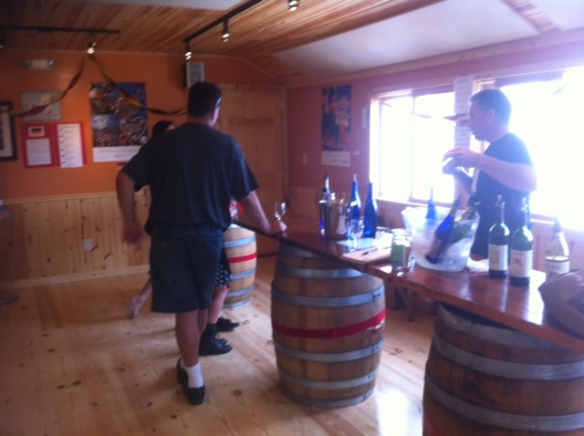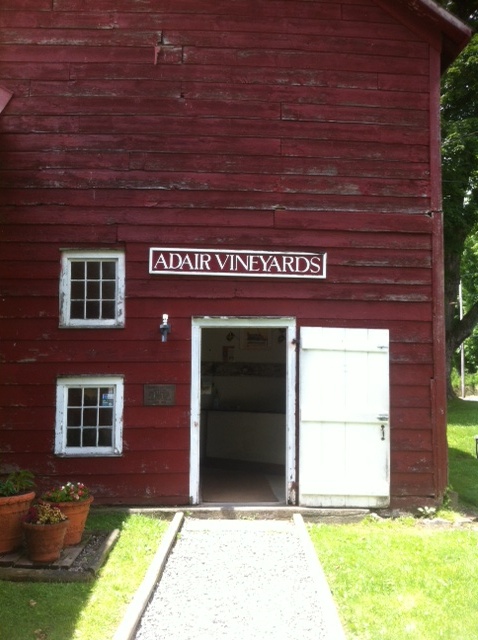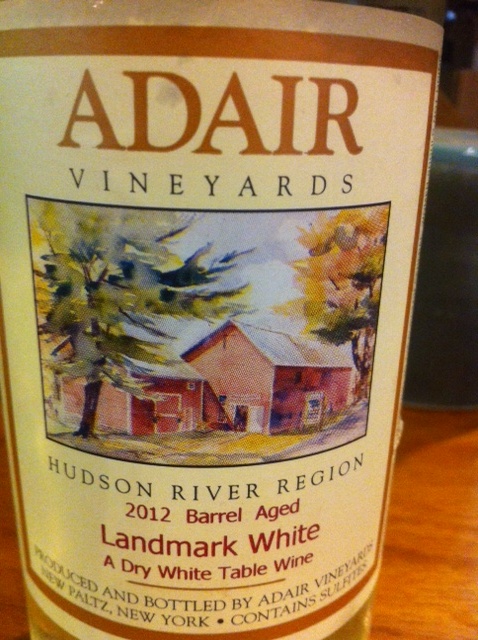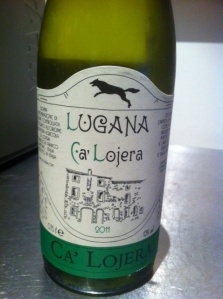This past weekend I decided to join the yearly Shawangunk Trail here in the Hudson Valley. It is a popular event that spans over two days, where people travel freely on their own between the dozen or so participating wineries in the region. People get to taste a selected number of wines from each winery, matched with food from around the world. An economical way to taste a large variety of local wines, it is also offers a good opportunity to become more familiar with each vineyard, meet the winemakers (sometimes) and learn what they specialize in, as well as being able to purchase their wine at a special discount.
Living in the Hudson Valley with wineries practically around the corner, I feel both a curiosity and a sense of obligation to check them out. For all intents and purposes, when reviewing NY wines I am not comparing them to any other wines. Not the wines from California or Oregon, nor France or Germany. Hell, I’m not really even comparing Hudson Valley wines to the ones from Finger Lakes or Long Island. It seems unfair, in a way, because their history, climate, culture and level of expertise.vary tremendously. Rather, each year I visit the vineyards, I hope to see progress in the wines and I was both pleased and disappointed on my recent trip.
Instead of trying to rush through all the wineries , I decided to make it a leisurely day and focus on five wineries this time: Benmarl Winery and Glorie Farm Winery, both located in Marlboro, Adair Vineyards and Robibero Family Vineyards in New Paltz, and finally Whitecliff Vineyards and Winery in Gardiner.
My first stop, Benmarl Winery, is conveniently located only about 30 minutes from my house, on the other side of the Hudson River. I’ve always been of the opinion that this is Hudson Valley’s most underrated winery, as I find their wines to be delicious and possess their own unique character. This is a small, charming winery in a gorgeous setting, and all their employees are incredibly warm and welcoming.

The first wine I tasted was the Slate Hill White, half Riesling and half Chardonnay, majority steel fermented with a small portion being oak fermented. This is a refreshing, straight forward wine with good fruit balanced with crisp acidity. I got flavors of lemon, grapefruit, pears, green apples and some pineapple. The wine had a bit of a hollow mid palate and disappeared a bit too quickly on the finish but overall a wine I would be happy to drink on the porch this summer. The next one, their Dry Rose, was a blend of 45% Merlot, 45% Cabernet Franc, 5% Traminette and 5% Chardonnay. Here I got that foxy note I sometimes get in wines where the grapes are sourced from Long Island and although there were some nice cherry and raspberry flavors in the wine, this aroma and flavor really takes over for me, and this was not my favorite.

Moving on to their Traminette was much more pleasant. The wine had a nice honeysuckle nose with floral aromas and tropical and lychee flavors as well as some nuttiness to it. I can see why many wineries in the region choose to make wine from this grape, as it seems to really thrive here. The fourth and last wine of the Shawangunk wine selection was the Slate Hill Red, a combination of Malbec (40%), Merlot (40%) and Cabernet Franc (20%). This too, had elements of the foxy aromas and flavors I dislike but less so than the rose. The common denominator here is the Cabernet Franc in the blend, and I suspect it is this grape variety causing this undesirable (to me) effect. The wine was nice and light in the mouth with soft tannins, and would be an appropriate summer wine if you want to stick with red.
I was fortunate enough to meet the proprietor of Benmarl, Victor Spaccarelli, who introduced me to his son and winemaker, Matthew. Matthew was gracious enough to bring me down to the cellar to taste a couple of their barrel samples. They are currently experimenting with their first ever sparkling wine made from 100% Chardonnay, which will be bottled in July. I was pleasantly surprised with the juice – refreshing, piercing acid (right now has a PH value of about 2.92, ,Matthew said), with a creamy texture and nice nuttiness adding layers of complexity. I look forward to picking up a bottle of this later this summer!
The second barrel sample I was offered was of their Reserve Chardonnay, which is ready to be bottled now. Made from two different Chardonnay clones, it is barrel fermented for about 2-3 months in 40-50% new oak (where they typically only use 20%), they use a mixture of Hungarian and neutral white oak barrels. The wine was full bodied with tropical fruit flavors of pineapple and mango, as well as vanilla, honey and oak, but I didn’t find the oak intrusive. A pleasant, balanced and well made wine – I can see it pair well with salmon, chicken and duck. Great way to end my first tasting and thanks to the entire staff at Benmarl for being such wonderful hosts.
Benmarl Winery, 156 Highland Avenue, Marlboro, NY 12542. Tel 845.236.4265. http://benmarl.com

What a fabulous beginning of the trail! Next stop was Glorie Farm Winery, about five minutes from Benmarl, where they offered tasters a choice of their dry or their semi-sweet/sweet flights. I selected the prior, hoping to find some new gems. I am not familiar with this winery, in fact it was my first time here although I have seen their wines around. Small but quaint property, I walked in with big hopes. The first wine poured was a Seyval Blanc 2010. Bright citrus with crisp acidity and a medium body, it showed some minerality and had a nice length. Not bad.

Moving on to the second wine, their Riesling 2011, this was semi-dry with a bit of a funky nose but provided good acidity, with flavors of ripe apples, pear and melon as well as some honeysuckle. Did it blow my mind? No, but I had no expectations going in here. The third wine, Dechaunac Oak 2010, this wine was aged for 12 months in oak barrels, but simply did not have the structure or body to take the oak treatment. I found the nose to be extremely buttery and with lots of vanilla aromas, while on the palate it was light bodied with red currants, some spiciness, earthy and herbal. Some foxiness as well. This wine needs some major adjustment or may be beyond help.

The flight was finalized with their Red Monkey, a blend of their estate reds and Cabernet Sauvignon (whatever that means, the person pouring seemed disinterested in chatting and was definitely not educated about the wines), it was aged for 4 months in both old French barrels and new American oak. Again, I found this wine to be very light bodied, and flavors that came through were red cherries and plum with some earthy undertones. Overall I am not impressed with this winery, I think they have ways to go before they are able to measure up to other New York producers.
Glorie Farm Winery, 40 Mountain Road, Marlboro, NY 12542. Tel 845.236.3265. http://gloriewine.com

With one positive and one not that great experience, I continued my journey to Adair Vineyards in New Paltz. Located in an old red barn, it is one of the more charming settings for a winery I think, and really makes you feel like you are “in the country”.

I had the pleasure of getting to know the proprietor and winemaker, Mark, a couple of years ago when we were both vendors at various farmers markets around the valley. Having studied at UC Davis and with experience from working at vineyards in Napa, Sonoma and Paso Robles among other places, he found his calling in New York, where he says there are “real” vintage variations and true challenges when making wine. I find Mark to be quite the authentic and passionate winemaker, always experimenting with his wines and taking chances. Here he is below (and the reason for his dreads/wig is that Adair was assigned Jamaica as a food region for the trail, it’s not how he normally dresses!)

Mark’s specialty is definitely in sweet wines, often blended with other fruits and berries such as peach and blackcurrant. The grapes are always sourced from his own estate and the berries and fruit from the surrounding farms in the Hudson Valley. He believes the fruit should originate 100% from the Hudson Valley in order to be called Hudson Valley wines. With only 1500-2500 cases produces per year, it is truly a treat to taste his wines.
The first wine in Adair’s line up was their Landmarc White 2011, a blend of 60% Seyval Blanc, 30% Cayuga White and 10% Vidal Blanc. Aged in a combination of 4 year old French, American and Hungarian oak barrels for 8 months, I found this to be a very fresh, lively wine with citrus, apple and pineapple flavors with the type of acidity and minerality often found in wines from northern Italy or Alsace. This would be a wine I would happily purchase in the store to mix it up from my other, more traditional French and Italian choices.

The second wine was their 2012 Kir Peche – this is a semi-dry style wine containing 90% Cayuga White and 10% peche (peach juice). This is perhaps for someone who like their wines sweeter or a novice needing something more approachable. Not my style of wine, but it’s well made and not to cloyingly sweet, and I would definitely add this in my sangria!
Moving on to wine #3, this was their Landmark Red, which was quite interesting, made from 50% Frontenac and 50% Leon Millot. I had never heard of or tasted the latter grape, Mark told me its parent is Pinot Noir, and is a French-American hybrid created in France. With a high resistance to fungal diseases, it thrives well in cool climates, produces a highly colored wine and is often blended with Pinot Noir. It is often grown in Burgundy outside the AC areas. The general flavor profile of Leon Millot include red and black fruits, as well as both chocolate and earthy notes.

The Landmark red had a nice garnet core with red cherries, plum and earthy flavors. A bit peppery with some herbal notes (thyme mostly), it was light to maybe medium in body. A lovely wine overall. I asked Mark what his formula was to get the wines balanced, and he said he picks his grapes twice; once at the lower end of ripeness, and the other half at slightly the higher end of ripeness. His beliefs are that if you pick them in the middle, the grapes develop a sort of funky (or what I refer to as foxy) aroma and flavor, that I often come across in other Hudson Valley wines, but none of this is present in Mark’s wines.
The fourth and final wine is Mark’s best seller, The Blackcurrant Kir Rouge 2012. A blend of 95% Dechaunac and 5% Blackcurrant wine, it has intense blackcurrant aromas, mixed with ripe plums and a nice thyme scent, which repeats on the palate.

I envision this pairing really well with cheese, as well as perhaps sneaking in a few drops into your sparkling wine for a refreshing brunch cocktail. This visit was definitely interesting, and it’s always infectious to chat with an enthusiastic winemaker such as Mark. Make sure you go visit him if you are in the Hudson Valley!
Adair Winery, 52 Allhusen Road, New Paltz, New York 1251. Tel 845.255.1377. http://adairvineyards.com
By this time, I was definitely in the groove, and ready for my fourth stop, the lovely vineyard belonging to the Robibero Family. This is a gorgeous winery, located not too far from my fifth and last stop, and perhaps more well known winery of Whitecliff. Harry Robibero and his wife come from Westchester, and purchased this winery in 2003, when there was an existing winery on the property. In 2007, that winery announced they were vacating the location and Harry and his family took over. I was lucky enough to meet them shortly thereafter, when my husband and I ran a catering company, Fork and Glass, and we catered a lovely wine dinner there in 2010 which was a lot of fun. Today, the winemaker is Kristop Brown, who learned to make wine under Eric Miller at Benmarl Winery, followed by a period in Walla Walla, Washington before returning to his roots in the Hudson Valley. Ryan Selby is Harry’s son-in-law, and he is the assistant winemaker, and his wife, Harry’s daughter Tiffany, manages the winery. This is truly a family affair, and every time I visit they are always so warm and welcoming, it makes me want to spend all day there! Since their vines are still young, most of the grapes used in their wines are sourced from other areas in New York, but I was happy to learn from Ryan that their very first vines will bear fruit this vintage, which will be a selection of Vidal Blanc, Lacrosse and Cabernet Franc. Excited to taste how these grapes will perform!

On to the wines… Wine # 1 was their 87 North, a blend of Vidal Blanc and Cayuga. The grapes were sourced from the Finger Lakes, and is a refreshing and delicate wine with flavors of pear, apple and melon. Crisp acidity with a fairly long finish, this is very well made and definitely worth trying out.

The second wine I tasted was their Dry Riesling 2011 (Double Gold Medal Winner at the Finger Lakes International Wine Competition). This was slightly off dry but with firm acidity, pineapple and honeysuckle on the palate. Overall a good wine, and suitable for an every day drinking wine. Wine #3 was their Arctic Riesling 2011, which I was excited about trying because of the somewhat silly reason that I also am the author of a food blog called Arctic Grub.

Arctic Riesling is known to survive in quite harsh and cold climates and produce wines with a distinct pear flavor. I found the aromas and flavor somewhat similar to a Sauvignon Blanc although with more layers of ripe fruit. It had some developing notes on the nose, intensely honeyed with pineapple, mango and peach flavors, finished on a leaner citrusy note. The length was a bit short, but this wine definitely has potential. Aged for 8 months in old 60 gallon Burgundy chardonnay barrels.
Moving on to red wines, the fourth wine was a treat, as I got to taste a barrel sample of their Cabernet Franc , made with 100% Cabernet Franc sourced from Cayuga Lake. Deep ruby core, with vanilla and ripe black fruit aromas, entering the palate, I sensed that familiar slight foxy flavor I get in Cabernet Franc from NY but it seemed to dissipate towards the end. Ripe red cherries, blackberries and blackcurrant, tannins and acidity were subtle but present, well integrated. I imagine this to be a pleasant wine when bottled, provided the foxy notes stay subdued.
Finally, the fifth wine I will mention was their 2010 Syrah, 100% Syrah from West Seneca. (I also had a few other samples but will reserve these for another post). This was a lovely and restrained wine, peppery with tart, red cherries, plums, sage and thyme flavors with a good tannic grip and firm acidity. Aged for 18 months in French oak barrels, this was a pretty, elegant wine with good structure that showed finesse. Perhaps my favorite red wine of all the wines I have tasted yet in the Hudson Valley

It is no secret that Robibero is one of my favorite wineries, if not my absolute favorite in the Hudson Valley. The quality of the wines are just superior, they do a great job despite their young age and short experience and although there can definitely be improvements, I see enormous potential for these guys in the future. Do yourself a favor and go visit them this weekend if you don’t have plans, and if you do, make sure you put it in your calendar this summer!
Robibero Family Vineyards, 714 Albany Post Rd, New Paltz, NY 12561. Tel 845.255.9463. http://rnewyorkwine.com
As I drove off to my fifth and final winery for the day, Whitecliff Vineyard & Winery, I felt happy I had only decided to visit five places that day. After all, impressions and senses are reduced and your taste buds completely desensitized after a certain amount of hours have passed. This was perhaps my fourth or fifth visit to Whitecliff, but I think at least a year has passed since the last time I had stopped in. The winery was perhaps the most crowded of the day but it was also later in the afternoon when the bigger groups move in. A bachelorette party was gathered outside and other guests were sitting around on the lovely lawn enjoying their lunch, as I headed in to the tasting room.

The first wine in the flight was their Rose, made from a blend of Cayuga and Dechaunac. Very fruit, verging on off dry, this medium bodied wine had flavors of strawberries, raspberries and some powdered sugar. Not as structured as I like my roses but a decent ‘sipper’. The second wine, Awosting White, a blend of Seyval Blanc and Vignoles, I remembered as being quite good when I tasted it a year or two ago. Sadly, the sample I received last weekend was incredibly sulfurous on the nose, and even worse on the palate. Rubbery and unclean, not a fresh note to be traced (although there may have been some apricot in there if you really turned up your imagination), this honestly tasted like wine gone bad. Hello, is anybody alive out here tasting this wine and thinking this is ok to release? Maybe I’m the crazy one.
Quickly on to wine number three, the Traminette 2012, this was off-dry with an extremely perfumed and floral on the nose with peach, apricot and roses on the palate. Decent, but didn’t really do it for me. To complete the tasting was the Red Trail – Raspberry w/Spice. This name made me laugh, also because it tended to confuse the not so savvy staff that were pouring the wines. A young girl who looked like she may have been a year shy of 12, was pouring the wine for some customers next to me, who were concerned about tasting it because one of the ladies was allergic to raspberries. The Whitecliff employee actually had to double check and make sure there was no raspberries in the wine before pouring. While this is a perfectly normal question for someone who is not familiar with wine and just eager to learn and taste, I would have expected more from someone who worked at the winery. Overall, I get more of a factory feel at Whitecliff, with random people who are not in the least knowledgeable about the wines they are pouring (training is perhaps overlooked?) and more importantly, I never quite understood the hooplah about their wines. This is my fourth of fifth time here, and I am underwhelmed by their wines, confused about what they are trying to achieve. I am happy people like their wines and that they are selling well in the area, but still trying to search for that wine that will make me jump on the bandwagon. Not one to give up, I will most likely visit again next year!
Whitecliff Vineyards & Winery, 331 McKinstry Road, Gardiner, NY 12525. Tel 845.255.4613 http://whitecliffwine.com







































